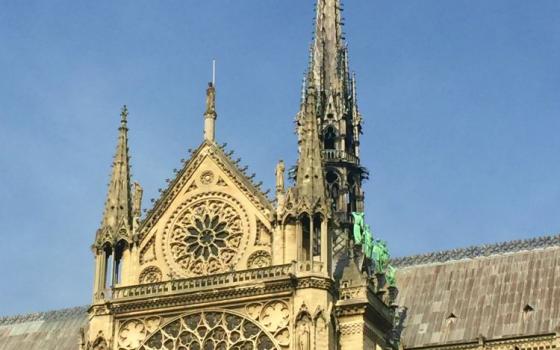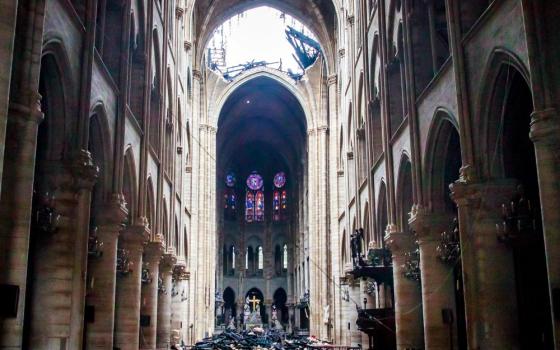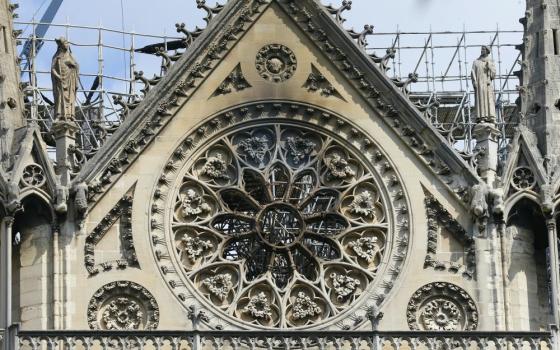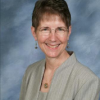It is hard for me to stop seeing the Notre Dame Cathedral in flames. This magnificent work of human imagination and skill is the icon of the worldview and religious belief system that has shaped so many of us.
Like the separation of Earth from heaven and hell, the sacred and secular needed to be kept separate. The cathedral was to be a taste of heaven, a mediating space between God and humans. In the mid-1960s when I first visited Notre Dame, I remember feeling awe as I turned my head upwards and took in the incredible heights and felt the transcendence of God. The deep silence that encompassed me as I entered brought me to prayer. The stained glass windows allowed the light to shine through the darkness reminding me of how God is present in this space.
Cathedrals embodied the religious imagination of the time, and when I visited Notre Dame it fed what was then my very personal "God and me" piety.
The Gothic cathedrals were central to the life of the people, the peasants, who found security, hope, and forgiveness within the walls of their churches. Cathedrals represented the values, the worldview and the belief systems that evolved over hundreds of years.
The cathedrals represented the space where God became present — mediated by the clergy through the sacraments. The clergy were the teachers of the faith, using stained glass windows and other iconography to tell salvation history. The architecture made order and geometric design a priority as well as conveying a sense of stability and permanence.
Notre Dame embodied these beliefs, but as with all structures over time, modifications occurred. Sometimes they strengthen the original design and sometimes they do not. It struck me as significant that what was destroyed — spire — was an addition over the centuries. The original base of the structure had withstood the fire and remained intact.
That began me thinking.
The dominant worldview and belief systems during the Middle Ages still exist, together with a variety of changes and developments in our religious and secular beliefs. We know that since the modern era the separation between world views rooted in religious beliefs and those emerging out of the discoveries of science have been at odds with each other. In an attempt to reconcile these differences, the teachings of the Second Vatican Council began a dialogue between the church and the world, but many in the official church resisted. One might say such resistance was simply adding on additions like the spire to the original base. Rather than seeing the original teachings of Jesus from a new vantage point, they added more of what they knew. This resistance has contributed to our present situation: Many people no longer go to church even while they search for a meaningful spirituality.
Another aspect of the more traditional worldview was the very special role for the clergy. By the Middle Ages, the church hierarchy resembled the existing monarchial structure. Within the cathedral some spaces were more sacred than others, where only the clergy or members of the monarchy were allowed to go. There were various designated roles within the priesthood that increased one's importance and privilege. Church rituals increased the unique role for the ordained clergy. Priests were obeyed without question and were looked upon as the representative of God by many of the faithful. The clerical system became more closed and out of touch with the changes in our world. Those additions to the clerical system have contributed to the current scandals in the church. Those additions — like the spire — are susceptible to fires as they, too, are not part of the base and distort the original Gospel vision.
As I listened to President Macron say that the cathedral would be rebuilt, I found myself wondering: What would happen if Notre Dame wasn't just rebuilt but rather reimagined?
How could what replaces what has been destroyed be as magnificent in design and speak to our contemporary spiritual understandings?
How would we build a cathedral today?
How would we embody an understanding of faith that deepens the Vatican II theology and its subsequent developments that we are in the world and not separate?
How would we construct our sacred space to integrate the cosmology that speaks to an unfinished and evolving Universe rather than an unchanging and fixed one and which honors the role of human consciousness?
How would we create the space in ways that acknowledge the equality of persons in all our diversity?
How would we convey the holiness of all of creation and our responsibility for the health of the planet?
How would we symbolize the intimacy of God as well as the transcendence and the various ways we access and experience the Divine?
How would the cathedral incarnate the Christ toward which all is evolving?
As I wondered, I realized my religious imagination needs a bit of work. The worldview and belief system that Notre Dame embodied had been imagined and shared for over a thousand years, through symbols, art, music, devotional prayers and rituals.
Vatican II occurred in the mid-20th century. We are just at the beginning of releasing our religious imagination. We need to embody our new understandings and interpretations of our faith using all of our senses and affectivity. We so need symbols, art, music, poetry, prayers and stories so we can embrace the intimacy and the grandeur of our faith within an emerging worldview.
Perhaps the gift from the ashes of Notre Dame is the release of our religious imagination so as to create over the next centuries as beautiful an icon for our future as Notre Dame has been for us during these past centuries.
[Nancy Sylvester is founder and director of the Institute for Communal Contemplation and Dialogue. She served in leadership of her own religious community, the Sister Servants of the Immaculate Heart of Mary, Monroe, Michigan, as well as in the presidency of the Leadership Conference of Women Religious. Prior to that, she was national coordinator of Network, the national Catholic social justice lobby.]



